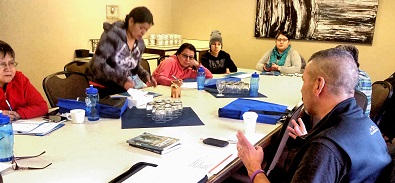Ernie Louttit speaks at the gang prevention and awareness session. Photo by Chelsea Laskowski
Some gang statistics are giving members of Peter Ballantyne Cree Nation quite a shock this week.
The information is part of the reserve’s annual Family Wellness Conference, which kicked off on Wednesday.
The workshops cover seven topics that attendees cycled through between Wednesday and Friday: like violence against women, suicide prevention, and gang awareness.
Within the gang awareness and prevention session, some elders from PBCN got their first lesson on how gangs are taking hold in their communities – this despite the fact that the spread of gangs into northern reserves has been a problem for more than a decade.
Retired Saskatoon officer Ernie Louttit – the Ontario Cree man’s nickname is ‘Indian Ernie’ – is opening the conversation with PBCN members. He worked with Saskatoon Police for 27 years, and spent 18 months with its gang unit. He was Saskatoon’s third aboriginal officer, and has since written two books on the topic of policing from a hands-on perspective.
Some elders from PBCN said they’ve noticed violence, and been frightened when they see people in hoods and bandanas around town, but were shocked to find out it’s related to gang activity.
Louttit explains the signs that gangs are taking root can start out subtle.
“Graffiti’s a good indicator of the start of gang activity or the start of that gang culture thing, gang signs, bandanas, all those things, imitating who they’re seeing in popular media,” he said.
Louttit shared another sign to watch out for:
“Graffiti, it’s huge, and that’s the broken window theory again, and I know a lot of people don’t like that and they say it’s over-policing, but not if it’s the community that’s fixing the broken window,” he said.
He says northerners – especially elders – can make a difference because even the toughest gang members he’s arrested for things like assaults, robber, even murder, remember where they came from.
“When you appeal to their traditional beliefs, and talk about the elders, and once the blood rush was gone and the violence was done, and you say ‘well what would your mushum think of what you did?’ It was pliable, like you could actually see the response in them where they were just deflated and all the rags and gang signs and all that stuff, were gone,” Louttit said.
He says bringing gang activity into the light is important because criminals thrive in secrecy.
At Louttit’s workshop, he told people what they can do.
“Every community should have an action plan for gangs, especially if they’re gang-free right now or just starting with gangs. Get together as a community, say what you’re going to stand for and stick with it,” he said.
Louttit says those initial things can be nipped in the bud, before drugs and violence become a part of it.
He recommends that each community sends a strong message that gang activity won’t be tolerated, because there’s strength in numbers.
“There’s certainly an opportunity to do something about it if everybody gets on the same page, makes a plan, and makes it uncomfortable to be a gang member on their First Nation or in their community,” he said.
He mainly provided suggestions for places with small gang presence, but attendees say areas like Pelican Narrows and Sandy Bay are dealing with real crime, caused by gangs that have taken root.
